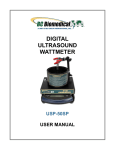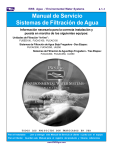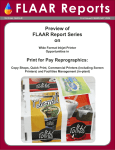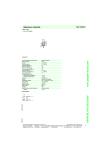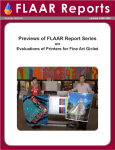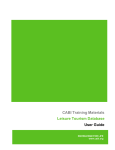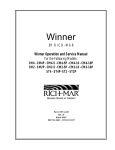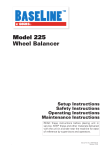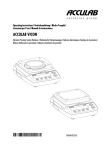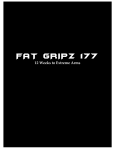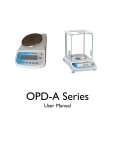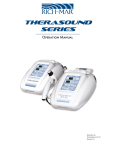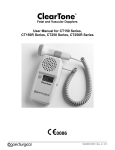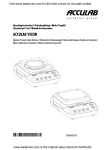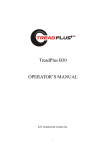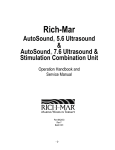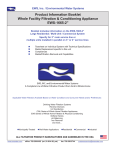Download PORTABLE ULTRASOUND POWER METER
Transcript
PORTABLE ULTRASOUND POWER METER MODEL USP-50 USER MANUAL BC BIOMEDICAL USP-50 TABLE OF CONTENTS Warnings, cautions, notices………………………………………………………….…….…….…....2 Introduction…………………………………………………………………………….…….…….…....6 Optional & Replacement Parts ...............................................................................................….6 Selecting a Location for Operation .........................................................................................….7 Panel Controls and Display Indicator .....................................................................................….7 Operating Procedure ..................................................................................................................7 Short Operating Notes...........................................................................................................…..8 Set Up....................................................................................................................................…..8 Calibration and Program Check ............................................................................................…..8 Serial Computer/Printer Interface ..........................................................................................…..9 USP-50 Parameter Settings Overview ..................................................................................…..9 Programming Print Control…………...………………………………………………..…………….. 9 USP-50 Parameter Settings for USB / RS-232 Interface…………….……………..……………..10 Setting Up HyperTerminal…………………………………………………………..…………………10 Shipping Instructions for the USP-50 ....................................................................................….10 Specifications.........................................................................................................................….11 Maintenance ..........................................................................................................................….12 Water, Temperature Considerations, Transducer Placement...............................................….12 Ultrasound Radiation Levels..................................................................................................….12 Pre-Amendment Acoustic Output Limits………………………………………………..…………...12 Theory of Measuring Ultrasound Power With the Radiation Force Method..........................….13 Warranty…………………………………………………………………………….…………………..14 Sample Inspection Record (2 pages) ..................................................................................….16 USP50_UserManual Rev8 1 WARNING - USERS The USP-50 Ultrasound Power Meter is for use by skilled technical personnel only. WARNING - USE The USP-50 Ultrasound Power Meter is intended for testing only and should never be used in diagnostics, treatment or any other capacity where they would come in contact with a patient. WARNING - MODIFICATIONS The USP-50 Ultrasound Power Meter is intended for use within the published specifications. Any application beyond these specifications or any unauthorized user modifications may result in hazards or improper operation. WARNING - CONNECTIONS All connections to patients must be removed before connecting the Device Under Test (DUT) to the Meter. A serious hazard may occur if the patient is connected when testing with the Meter. Do not connect any leads from the patient directly to the Meter or DUT. WARNING - BATTERIES Turn Power Off and unplug any Battery Eliminator before replacing batteries or cleaning the surface of the Meter. WARNING - LIQUIDS Do not submerge or spill liquids on the Meter. Do not operate the Meter if internal components not intended for use with fluids may have been exposed to fluid, as the internal leakage may have caused corrosion and be a potential hazard. 2 CAUTION - SERVICE The USP-50 Ultrasound Power Meter is intended to be serviced only by authorized service personnel. Troubleshooting and service procedures should only be performed by qualified technical personnel. CAUTION - ENVIRONMENT The USP-50 Ultrasound Power Meter is intended to function between 15 and 30 °C. Exposure to temperatures outside this range can adversely affect the performance of the Meter. CAUTION - MEDIA The USP-50 Ultrasound Power Meter is to be used only with degassed water. Use of any other media may cause damage a to the meter and give erroneous results CAUTION - INSPECTION The USP-50 Ultrasound Power Meter should be inspected before each use for wear and the Meter should be serviced if any parts are in question. 3 NOTICE – SYMBOLS Symbol Description Caution (Consult Manual for Further Information) Center Negative Direct Current NOTICE – ABBREVIATIONS c centi- (10-2) C Celsius cmH20 centimeter water ° degree DUT Device Under Test Euro European F Fahrenheit FS Full Scale hrs Hz inHg inH20 k hours hertz inches mercury inches water kilo- (103) kg/cm2 kilograms per centimeter squared kHz kilohertz Kpa kilopascal μ micro- (10-6) μA microampere m milli- (10-3)- mA milliampere mBar milliBar mm millimeter mmHg millimeter mercury ohm Press Pressure PSI pounds per square inch PSIG pounds per square inch gauge Sec seconds Temp temperature US United States V volt VDC Direct Current Voltage 4 NOTICE – DISCLAIMER USER ASSUMES FULL RESPONSIBILITY FOR UNAUTHORIZED EQUIPMENT MODIFICATIONS OR APPLICATION OF EQUIPMENT OUTSIDE OF THE PUBLISHED INTENDED USE AND SPECIFICATIONS. SUCH MODIFICATIONS OR APPLICATIONS MAY RESULT IN EQUIPMENT DAMAGE OR PERSONAL INJURY. NOTICE – DISCLAIMER BC GROUP INTERNATIONAL, INC. RESERVES THE RIGHT TO MAKE CHANGES TO ITS PRODUCTS OR SPECIFICATIONS AT ANY TIME, WITHOUT NOTICE, IN ORDER TO IMPROVE THE DESIGN OR PERFORMANCE AND TO SUPPLY THE BEST POSSIBLE PRODUCT. THE INFORMATION IN THIS MANUAL HAS BEEN CAREFULLY CHECKED AND IS BELIEVED TO BE ACCURATE. HOWEVER, NO RESPONSIBILITY IS ASSUMED FOR INACCURACIES. NOTICE – CONTACT INFORMATION BC BIOMEDICAL BC GROUP INTERNATIONAL, INC. 3081 Elm Point Industrial Drive St. Charles, MO 63301 USA 1-800-242-8428 314-638-3800 www.bcgroupintl.com [email protected] Manual USP-50 www.bcgroupintl.com 08/08 Copyright © 2008 Made in the USA Rev 08 5 INTRODUCTION The measurement of power output levels of diagnostic and therapeutic ultrasound equipment has become increasingly important to determine exact patient exposure levels in case a potential risk exists to the patient. Since the Radiation Control for Health & Safety Act of 1968 and the 1976 Medical Device Amendments to the FDA Act became effective, all manufacturers of diagnostic Doppler ultrasound equipment are required to submit information regarding their maximum peak and average exposure level, beam patterns, and other pertinent information. Hospitals are responsible for regularly scheduled testing (every six months) of output power and safety to maintain their accreditation. The Portable Ultrasound Power Meter, Model USP-50, is designed to measure the ultrasound power output of diagnostic or therapeutic transducers up to 30 watts. The power meter comes complete with all accessories (clamp assembly, cone assembly, power supply, and tank) in a sturdy foam padded carrying case (picture right). The water tank requires only one pint of de-gassed distilled water. If de-gassed water is not available, use distilled water. The principle of measurement is the radiant force method. The meter uses a positioning clamp to hold the transducer in de-gassed water above a conical target. The ultrasonic energy passes through the water to reflect off the target and is then absorbed by the rubber lining. The radiant power is directly proportional to the total downward force (weight) on the target. This weight is then transferred through the target support assembly to the electro-mechanical load cell inside the scale. The cell is in a computercontrolled feedback loop and produces a digital readout in watts of power (custom units) or grams of force. The choice of units (grams or watts) is selected by front panel pushbutton. The USP-50 is supplied with a plug-in 120 VAC adapter (using another adapter not rated the same may damage unit). The display resolution is 50 milliwatts. The following replacement parts can be ordered from BC GROUP : x x x x x OPTIONAL & REPLACEMENT PARTS Positioning Clamp Assembly Cone Assembly 120 VAC power adapter # MKD-351500100 USB Cable #YADAP-USB RS-232 Cable #YADAP-RS Front view of the USP-50. Shown is the electronic balance, base assembly, and test tank. 6 USING THE PORTABLE ULTRASOUND POWER METER SELECTING A LOCATION FOR OPERATION The USP-50 should always be used in an environment free from excessive air currents, corrosives, vibration and temperature or humidity extremes. These factors will affect the displayed readings. DO NOT operate the USP-50: x x x x x Next to open windows or doors causing drafts or rapid temperature changes Near air conditioning or heat ducts Near vibrating, rotating or reciprocating equipment Near magnetic fields or equipment that generate magnetic fields On a non level work surface PANEL CONTROLS & DISPLAY INDICATOR 1 2 3 1. 2. 3. 4. 5. 6. ON/OFF ZERO CAL F ENTER PRINT 4 5 6 Press to turn unit on or off. Press to zero unit, press as instructed for access and exit from parameter settings. Used for calibration. Function button, toggles between “grams” and “user defined (Watts) “ modes. Used in calibration and setting parameters. Print command, press to print reading. Display output Grams Mode xxx.xxx g Custom Mode xx.xx R(Watts) OPERATING PROCEDURE 1. Remove the USP-50 from the carrying case and place on a solid level surface. Loosen the positioning clamp and position it out of the way. 2. Remove the tank and place it in the black holder on the meter. 3. Remove cone target assembly place it in the target support sleeve in back of the tank, while simultaneously placing the cone in the tank. 4. Fill the test tank to ¼ inch below the top of the rubber liner with recently de-gassed water at room temperature. (To obtain de-gassed water, boil distilled water for 15 minutes, fill a jar completely, cover, and allow to cool). 5. Plug the AC Adapter into a 120 VAC, 60 Hz power outlet and plug it into the power jack at the rear of the unit. Depress the ON/Off button. Let the unit stabilize a few minutes, once stable press ZERO. 6. By means of the positioning clamp, attach the transducer head and place its radiating face 1/8 inch below the water level, parallel to the water surface, and directly above the center of the cone. Check transducer surface for uniform wetting (no air pocket or bubbles should be on its surface). 7 7. With no ultrasonic power applied to the transducer, press the ZERO button to zero the USP-50. 8. Check response by placing the 1gram test weight on the arm of the cone target ( the flat part that is out of the water). The USP-50 should read 1.00 grams ± 0.05. Change the units to the watts mode by pressing the “F” button. The USP-50 should read 14.65 watts ± 0.05 watts. 1 gram is equal to 14.65 watts. 9. Remove the 1 gram weight. Press the ZERO button to zero the unit. 10. Apply power to the Transducer Under Test (TUT). Re-zero before each measurement and take your power reading when the display has stabilized. It is a good practice to take three readings and average them. If measurement conditions are not stable, use the grams mode and multiply the readings by 14.65 to obtain watts . 11. Determine the maximum peak power with the maximum duty cycle and pulsed output settings with the equation: PAVE = Pp ÷ Rtpa PAVE = calculated average power Pp = Peak Pulsed Power Setting on unit under test Rtpa = Ratio of Temporal Peak to Average Power (from each manufacturer) 12. To calculate the watts/cm2 output, take the total watts reading from the unit and divide by the area. The area is Sd2÷ 4 (d is the diameter of the transducer) if the transducer is smaller than the cone. Otherwise, use (8.2 cm) the cone’s diameter as the area. 13. When finished, unplug the USP-50, empty and dry the tank. Dry the cone target assembly. Place the unit, tank, cone target assembly, and power adapter into the padded case. SHORT OPERATING NOTES Line / Power: The USP-50 is supplied with a 120 VAC adapter. Check for correct line voltage before use. For voltages 220/240 VAC, an optional power adapter can be ordered from BC GROUP. Short Operating Notes Model USP-50 1. Remove all the parts from the carrying case. Move the positioner / holder upright. Place the tank into the holder. Insert the cone into the tank and the cone holder into the target support sleeve located in back of the test tank. Add water (no visible bubbles) to approximately one-quarter inch below the top of the tank. 2. Turn unit on by pressing the ON/OFF button. Zero by pressing “ZERO”. 3. Place the 1 gram weight gently on the cone support arm. A reading of one gram equals 14.65 watts. Remove the 1 gram test weight. 4. Put the transducer of the equipment under test (EUT) into the positioner / holder approximately one-eighth inch into the water and centered above the cone. Zero the scale. Turn on the power to EUT and take readings. 5. Turn off the USP-50 by pressing the ON/OFF button. SET UP: If you accidentally get into the Parameter Setup menu you can get out by pushing and holding the ZERO Button until the unit turns off, release the button and the unit will turn back on. The USP-50 Portable Ultrasound Power Meter is a custom programmed balance with additional hardware (cone target, tank, etc.) designed to provide ultrasound power readings. If reprogramming to the original parameters does become necessary, the unit must be returned to BC GROUP’S facility in St. Louis, MO. An hourly labor rate will be charged for any necessary repairs and recalibration fees will be assessed. A calibration certificate will be returned with the unit. CALIBRATION and PROGRAMMING CHECK A 1-gram weight is supplied to check the calibration and programming. With the transducer under test turned off, zero the unit. Place the weight on the arm of the cone target assembly. Within 3 seconds the unit should read 14.65 watts (± .05 watts) or 1.0 grams (± .005 grams). If this reading is significantly off, the USP-50 needs to be recalibrated. Send it to BC GROUP for calibration. It is recommended that the USP-50 be returned to BC GROUP on a yearly basis for calibration and certification. 8 SERIAL COMPUTER/PRINTER INTERFACE The USP-50 can be used with an optional USB or RS-232 interface cable for communication with printers and computers. Installation instructions come with the cable. When the meter is connected directly to a printer, displayed data can be output at any time by simply pressing PRINT or by using the Auto Print feature. Connecting the meter to a computer enables you to operate the meter from the computer, as well as receive data. The program used is the communication program HyperTerminal found on most Window operating systems. The setup of this program is with the cable instructions. USP-50 PARAMETERS SETTINGS OVERVIEW Menu Level 1 1 Weighing Menu Level 2 1.1 Adapt Filter Menu Level 3 Default Menu item 1.1.1 Very stable conditions 1.1.2 2 Stable conditions 1.1.3 Unstable conditions 1.1.4 Very unstable conditions 1.2 Application filter 1.2.1 2 Final readout 1.2.2 Filling 1.3Stability range 1.3.1 1/4 digit 1.3.2 1/2 digit 1.3.3 1 digit 1.3.4 2 2 digits 1.3.5 4 digits 1.5 Function of CAL. 1.5.1 2 CAL adjustment 1.5.1 Linearization, service only 1.5.3 key blocked 1.6 Auto zero 1.6.1 2 On 1.6.2 Off 1.7 Units Toggle 1.7.1 to 1.7.23 * Set to User def. And grams 5 and 6 Only relevant with optional USB or RS 232 connection 8 Additional Functions 8.1 Block keys 8.2 Auto shut off 9. Reset menu 8.1.1 8.1.2 8.2.1 8.2.2 8.2.3 9.1 Factory settings 2 2 9.1.1 9.1.2 2 * Set to User defined and grams. "F" toggles between the two. Only On/Off Zero unblocked All unblocked After 2 minutes After 5 minutes After 10 minutes Restore Do not restore PROGRAMMING PRINT CONTROL The default print set up is 6.1.2 “Manual with stability”. The unit will send one reading to a computer or printer when requested, by PRINT key on the unit or by the computer. To set to Automatic printing: If the meter is on, turn it off. Turn the unit on, while all the segments of the display are lit, press and hold “ZERO” (about 2 seconds). Release when the display reads “1.”. This is the set up mode. Press “F” twice. Display will read “6.1.X”. Press “ENTER” until the desired setting is shown. Either 6.1.3 “Automatic w/o stability” or 6.1.4 “Automatic at stability”. Press and hold “ENTER” to accept set up”, display will show “6.1.X” with a small “O” behind it. Press and hold “ZERO” until meter turns off, then release the button. The unit will turn back on. 9 USP-50 PARAMETER SETTINGS FOR THE USB /RS-232 INTERFACE Menu Level 1 5 Data interface Menu Level 2 5.1 Baud rate Menu Level 3 Default Menu item 5.1.2 300 baud 5.1.3 600 baud 5.1.4 2 1200 baud 5.1.5 2400 baud 5.1.6 4800 baud 5.1.7 9600 baud 5.1.8 19,200 baud 5.2 Parity 5.2.3 5.2.4 5.2.5 2 Odd Even None 5.3 Stop bits 5.3.1 5.3.2 2 1 stop bit 2 stop bits 2 Software (Xon-Xoff) USB Hardware RS-232 None 5.4 Handshake mode 5.4.1 5.4.2 5.4.3 6 Printing 6.1 Manual/Auto print 6.1.1 6.1.2 2 Manual w/o stability Manual at stability SETTING UP HYPERTERMINAL The USP-50 will print to a computer screen using a terminal emulation program. One program HyperTerminal is packed with most computers and will work for this feature. To set up this program to work with the USP-50 and a computer running Windows XP see the following: Left click on START Highlight ALL PROGRAMS Highlight ACCESSORIES Highlight COMMUNICATIONS Double left click on HYPERTERMINAL or Left click on a setup to open HyperTerminal. In the HyperTerminal program box Left click on FILE, then Left click on NEW CONNECTION In the New Connection box, type in a name; Ex: (USP-50). Click on any icon, then Left click OK In the Connect To box set the connect using line to the correct port. Left click on the down arrow to see your ports available. Choose one then Left click OK. In the COM (#) Properties” box (# is the port assigned), under PORT SETTINGS set the following Data Bits……..1200 Parity………….7 Stop Bits……...1 Flow Control…Hardware Left click OK . HyperTerminal is now set up to allow the USP-50 to communicate with a computer and print to the screen. 10 SHIPPING INSTRUCTIONS FOR THE USP-50 To make certain that your Ultrasound Power Meter arrives at our repair department unharmed during shipment, please follow these instructions: 1. Pack unit as instructed in “Operating Procedure” part #13 on page 5. 2. The package used for shipping should be strong and large enough to allow for adequate packing material on all sides of unit. DO NOT SHIP THE USP-50 WITHOUT A SHIPPING CONTAINER! 3. Ship to: BC Group International, Inc. 3081 Elm Point Industrial Drive St. Charles, MO 63301 8. Enclose paperwork (packing slip, purchase order form, letterhead) which includes your return address, contact name and telephone number. A description of the work that needs to be done would be helpful. By using the above instructions you will avoid additional charges which can be incurred if the unit is not packaged well enough to withstand the possible rough handling during shipment. BC GROUP cannot be held responsible for damage if these instructions are not followed. SPECIFICATIONS Power Range 0 to 30 Watts Resolution +50 mW Minimum Detectable Power 50 mW Display Sensitivity 0.05 Watt Accuracy ±3% + One Count Stabilization 2.5 Second Integration Maximum Weight Capacity 400 Grams Maximum Transducer Size 3” Diameter Transducer Operating Frequency 0.5 to 10 MHz Test Media Degassed Water Computer Interface (Optional) USB or RS-232 Default Baud Rate 1200 Power Supply 120 VAC to 15 VDC, 100 mA adapter with 6-Ft. Cord. 240 VAC optional. EMC Conforms to EN 61326-1, EN 61326-1 Class B Electrical Safety Conforms to EN 60950, EN 61010 Size 5.0” x 10” x 8.5” (H x L x W) Weight 10 Lbs. Net w / case Carrying Case 6.0” x 17.0” x 12.0” (H x L x W) padded case 11 MAINTENANCE Out of Measurement Range Warnings: Model USP-50 accommodates weight differential of ± 400 grams. When the scale exceeds this range, “oL” error will be displayed. Something may be pressing hard on the target or support. An “uL” indicates underweight condition. If no obvious error has been made by the user the unit should be returned for service when any code is displayed. No Display: Make sure the AC adapter’s plug is fully seated in the jack at the back of the unit. Call our service department for assistance. WATER, TEMPERATURE CONSIDERATIONS & TRANSDUCER PLACEMENT Water as a Measurement Medium: The measurements are to be performed in de-gassed water because ultrasound propagation in water closely approximates that in tissues (see UL-1-1981, AIUM/NEMA Standard Publication). The ultrasonic attenuation in water can be taken as a lower limit on the attenuation which will be encountered in the body. Large areas in the body can consist of low attenuating material such as urine and amniotic fluid. The use of water prevents measurements in a more highly attenuating material such as liver equivalent gels from representing the highest possible intensities which might be encountered in the body. A measurement temperature of 24°C ± 3°C (75°F ± 5°) is chosen for convenience. De-Gassed Water: Ultrasound power measurement accuracy is affected (lowering the power reading) if the water contains more than five parts per million of air. To de-gas, boil water for 15 minutes, then pour into a suitable heat resistant container, seal tightly and place in refrigerator to cool. This process will give the required quality. Before testing, pour water into tilted test tank to minimize turbulence. An alternative method of de-gassing water is to heat the water to boiling, then pull a vacuum for five minutes. Water Temperature: Water temperature affects accuracy; use a testing temperature of 21 to 27°C ambient. Sonic energy agitates the water surface through heating and scattering. Testing time should be limited to a few minutes; prolonged testing, particularly at higher power levels, will produce air bubbles. Transducer Wetting and Placement: After tilting the transducer into the water at a 45° angle, verify that the surface is uniformly wetted. The transducer should be positioned above the cone target. Small variations will occur due to placement. Try various positions above target to obtain a maximum power reading. ULTRASOUND RADIATION LEVELS There are no maximum limits in the U.S. for therapy power, only the verification of the displayed setting accuracy to ± 20% of actual output is required. Exposure levels for physical therapy applicator heads range from 100mW/ cm2 to 3W/cm2. Total power requires multiplication by the radiated cross sectional area in cm2. The power limits shown in the following table for diagnostic ultrasound have been extracted from FDA Section 510(k) guidance to manufacturers on submissions and clearance as of February 1993. Refer to the AIUM and FDA publications for complete and up to date testing standards and interpretations. Measurements are done in all standard modes of operation. Power intensity is rated as Spatial Peak Temporal Average (ISPTA) and Spatial Peak Pulse Average (ISPPA). The values in mW/cm2 are derated for tissue and in parenthesis for the water medium (use this chart): PRE-AMENDMENT ACOUSTIC OUTPUT LIMITS ISPTA Tissue (mW/cm2) Water ISPPA Tissue (mW/cm2) Water Peripheral Vessel 720 1500 190 350 Cardiac 430 730 190 350 Fetal Imaging & Other * 94 180 190 350 Ophthalmic 17 68 28 110 Use 12 Abdominal, intra-operative, pediatric, small organ (breast, thyroid, testes, etc.), neonatal cephalic, adult cephalic. THEORY OF MEASURING ULTRASOUND POWER WITH THE RADIATION FORCE METHOD Sound is a form of energy that sets the particles in the isonated medium into vibrational motion. The particles then possess a kinetic energy. If dPm is the rate of the flow of this energy about an area dA, then the mean acoustic energy is: Eq. 1 I = dPm/dA I = Acoustic intensity at a point in that area, Watts/cm2 When a plane sound wave propagates through a uniform non-absorbent medium, the intensity must be the same for all points in the wave. Let E represent the energy density, i.e., the energy per unit volume. When the sound energy passes through a unit cross-sectional area with a speed c, the intensity is: Eq. 2 I = cE E = Energy density per unit volume, ergs/cm3 c = Ultrasound wave velocity, cm/sec The radiation pressure effect can be explained by analogy to the application of an alternating electric voltage to a non-linear load. With the non-linear load it appears that both AC and DC components are present. In ultrasonics the non-linear element is the density of the fluid and hence acoustic impedance (load) varies in the same periodical manner as the density. Therefore in ultrasound the two components of pressure, one alternating and the other direct are present. The average AC pressure per cycle is zero, but the DC pressure of radiation is: Eq. 3 PW = I/C PW = Pressure of Radiation, ergs/cm3 Therefore, from the above two equations, the pressure of radiation (PW) is equal to the energy density (E). Eq. 4 PW = E It is this DC pressure of radiation that can be measured. At low frequencies, below 100 KHz, a standard high frequency hydrophone can be used. For higher frequencies, generally used in medical applications, 1-15 MHz, hydrophones are not available. At these frequencies the force can be measured using a precision balance and a radiation force target that is perfectly absorptive. The conversion from force to power can be accomplished using the equation: Eq. 5 p = Wgc W = measured force, grams g = acceleration, dynes c = velocity of ultrasound, cm/sec p = power, ergs/sec By combining all constants together and converting from ergs/sec to watts, we obtain a simplified equation that is used to calculate the ultrasonic power once the force is measured: P = w(14.65) P = Ultrasonic power in watts w = Ultrasonic force in grams To determine the ultrasonic watt density (watts/cm2 or watts/in2) of a given transducer the P is divided by the cross sectional area of the transducer. 13 WARRANTY Not withstanding any provision of any agreement the following warranty is exclusive. BC GROUP warrants each instrument it manufactures to be free from defects in material and workmanship under normal use and service for the period of 1-year from date of purchase. This warranty extends only to the original purchaser. This warranty shall not apply to fuses or any product or parts which have been subjected to misuse, neglect, accident, or abnormal conditions of operation. In the event of failure of a product covered by this warranty, BC GROUP will repair and recalibrate an instrument returned within 1 year of the original purchase: provided the warrantor's examination discloses to its satisfaction that the product was defective. The warrantor may, at its option, replace the product in lieu of repair. With regard to any instrument returned within 1 year of the original purchase, said repairs or replacement will be made without charge. If the failure has been caused by misuse, neglect, accident, or abnormal conditions of operations, repairs will be billed at a nominal cost. In such case, an estimate will be submitted before work is started, if requested. THE FOREGOING WARRANTY IS IN LIEU OF ALL OTHER WARRANTIES, EXPRESSED OR IMPLIED, INCLUDING BUT NOT LIMITED TO ANY IMPLIED WARRANTY OF MERCHANTABILITY, FITNESS, OR ADEQUACY FOR ANY PARTICULAR PURPOSE OR USE. BC GROUP SHALL NOT BE LIABLE FOR ANY SPECIAL, INCIDENTAL, OR CONSEQUENTIAL DAMAGES, WHETHER IN CONTRACT, TORT, OR OTHERWISE. If any failure occurs, the following steps should be taken: 1. Notify BC GROUP giving full details of the difficulty, and include the model, type, and serial numbers (where applicable). On receipt of this information, service data, or shipping instructions will be forwarded to you. 2. On receipt of shipping instructions, forward the instrument, transportation prepaid. Repairs will be made and the instrument returned, transportation prepaid. SHIPPING TO MANUFACTURER FOR REPAIR OR ADJUSTMENT All shipments to BC Group International, Inc. should be made via FedEx or "Best Way" prepaid. The instrument should be shipped in the original packing carton, or if it is not available, use any suitable container that is rigid and of adequate size. If a substitute container is used, the instrument should be wrapped in packing material and surrounded with at least four inches of excelsior or similar shock absorbing material. CLAIM FOR DAMAGE IN SHIPMENT TO ORIGINAL PURCHASER The instrument should be thoroughly inspected immediately upon delivery to purchaser. All material in the shipping container should be checked against the enclosed packing list. The manufacturer will not be responsible for shortages against the packing sheet unless notified immediately. If the instrument is damaged in any way, a claim should be filed with the carrier immediately. (To obtain a quotation to repair shipment damage, contact BC Group.) Final claim and negotiations with the carrier must be completed by the customer. BC GROUP will be pleased to answer all application or use questions, which will enhance your use of this instrument. Please address your requests or correspondence to: BC Group, 3081 Elm Point Industrial Drive, St. Charles, MO 63301 or call BC GROUP Technical Support at 800-242-8428. All rights reserved. This manual may not be reproduced in complete form without written permission of BC Group International, Inc. Test forms may be copied as required by the original purchaser of the instrument. Information contained within this manual is believed to be accurate and reliable. However, BC Group International, Inc. assumes no liability for its use. BC Group International, Inc. reserves the right to supply its instruments with design changes and/or component substitutions that may not be documented in this manual. 3081 Elm Point Industrial Drive, St. Charles, MO 63301 Voice: (800) 242-8428 Fax: (314) 638-3200 www.bcgroupintl.com email: [email protected] 14 NOTE PAGE 15 16 9. CONTINUOUS WAVE MODE CERTIFICATION (Average Power) WATTS SELECT POWER ON OFF DIFF. WATTS ALLOWABLE 3.7 - 6.3 5 SAT. WATTS SELECT POWER ON OFF DIFF. SAT. UNSAT. WATTS ALLOWABLE SAT. WATTS SELECT POWER ON OFF DIFF. WATTS UNSAT. SAT. WATTS ALLOWABLE SAT. WATTS SELECT POWER ON OFF DIFF. WATTS Average of 3 Readings CALCULATIONS DIFF. ON WATTS OFF (Pp) Average of 3 Readings Pp RTPA CALC. AVERAGE POWER (Pp / RTPA) = Measured Average Power (Av) Difference Between Measured AV And Calculated AV Is Difference < ± 0.6% Of (Pp / RTPA) YES NO 11. SHORT TERM LIFE TEST COMPLETE? YES NO 12. ADDITIONAL TEST (Describe in Detail): 17 ALLOWABLE SAT. UNSAT. 10. PULSED MODE CERTIFICATION (Amplitude Modulated Waveform) POWER UNSAT. Average of 3 Readings Average of 3 Readings MAX. PULSE MODE ALLOWABLE 14.8 - 25.2 20 Average of 3 Readings DIFF. ALLOWABLE 7.4 - 12.6 UNSAT. 11.1 - 18.9 POWER ON OFF WATTS Average of 3 Readings 15 WATTS SELECT DIFF. 10 Average of 3 Readings WATTS SELECT POWER ON OFF REMARKS UNSAT.



















